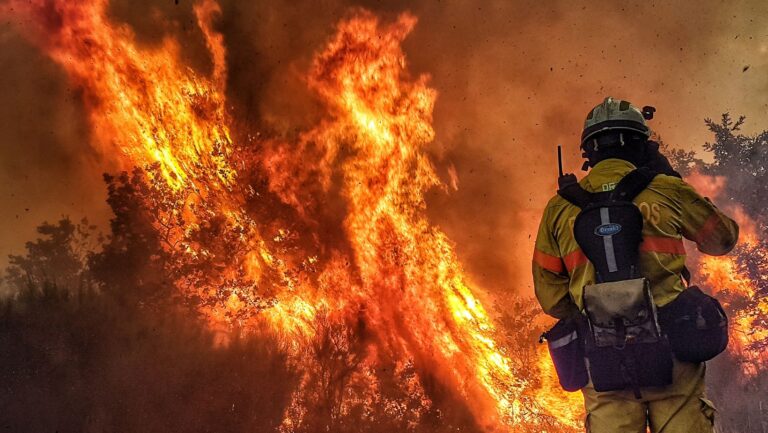Last Updated on February 22, 2024 by Deanne Robertson
Firefighters play a crucial role in safeguarding communities, often exposing themselves to various occupational hazards. One such concern is the prolonged exposure to aqueous film-forming foam (AFFF), a firefighting agent widely used to combat flammable liquid fires.
While AFFF is effective in controlling fire, recent studies have raised concerns about its potential adverse effects on the health of firefighters. In this article, we will explore the occupational health challenges associated with extended AFFF foam exposure.
The Prevalent Use of AFFF in Firefighting
AFFF has become popular in firefighting operations globally due to its unparalleled efficacy in suppressing flammable liquid fires. Firefighters rely on this foam to rapidly control and extinguish fires involving substances like gasoline and jet fuel.
Its wide usage extends to industrial settings, airports, and military installations. Despite its effectiveness, concerns have surfaced regarding the potential health impacts on firefighters exposed to AFFF regularly. As AFFF usage continues to be integral to firefighting strategies, understanding the associated risks becomes paramount for developing safer firefighting practices.
The Chemical Composition of AFFF
AFFF contains per- and polyfluoroalkyl substances (PFAS), a class of chemicals known for their persistence in the environment and potential health risks. PFAS is associated with various adverse health effects, including links to cancers, reproductive issues, and immune system disorders.
As noted by NIH, firefighters’ exposure to AFFF raises concerns about the absorption of PFAS through inhalation, ingestion, and skin contact. They have been found to have an increased level of PFAS in their blood.
The long-term health implications of these exposures require comprehensive research to establish clear connections and inform protective measures for firefighters, ensuring their well-being.
Respiratory Health Risks and AFFF Exposure
The inhalation of AFFF particulates during firefighting activities poses a substantial risk to respiratory health. Firefighters are exposed to airborne particles and vapors released during the application of AFFF. Short-term effects may include respiratory distress, irritation, and coughing.
Over time, chronic respiratory conditions such as asthma and bronchitis may develop.
Implementing stringent respiratory protection measures, regular health screenings, and research into the respiratory risks associated with AFFF exposure are crucial for mitigating these concerns.
Skin Contact and Dermatological Concerns
Firefighters frequently come into direct contact with AFFF-saturated equipment, leading to potential dermatological issues. As noted by ITRC, skin exposure to AFFF may result in irritation, redness, and rashes, with some cases escalating to more severe conditions.
Adherence to strict personal protective equipment (PPE) guidelines, regular hygiene practices, and skin health monitoring are necessary. This helps minimize the risks of dermatological complications associated with AFFF exposure and ensures the overall well-being of firefighters.
Mental Health Challenges in the Face of Uncertainty
The uncertainty surrounding the long-term health effects of AFFF exposure contributes to significant mental health challenges for firefighters. Anxiety, stress, and fear of potential health consequences can impact their overall well-being and job performance.
Addressing these mental health concerns requires proactive measures. This includes mental health support programs, education on the known risks, and open communication channels to alleviate the psychological burden on firefighters. This promotes a healthier and more resilient firefighting community.
Legal Ramifications and Emerging Lawsuits
The increasing awareness of AFFF-related health risks has led to a surge in lawsuits filed by firefighters and their families against AFFF manufacturers. As per a February 2024 update from ConsumerNotice.org, there are currently 6,994 pending lawsuits in the U.S. District of South Carolina.
Allegations in these lawsuits often include failure to adequately warn about health risks and negligence in product development. Misrepresentation of the safety profile of firefighting foam is another common allegation in the AFFF foam lawsuit. Plaintiffs argue that manufacturers downplayed or concealed the known health risks associated with PFAS exposure, potentially putting users at greater risk without their knowledge.
This alleged lack of transparency has contributed to a growing demand for accountability within the firefighting foam industry. According to TorHoerman Law, these lawsuits shed light on the need for accountability within the industry. They are expected to serve as catalysts for stricter regulations and improved safety standards for AFFF use in firefighting.
Strategies for Mitigating AFFF Exposure
To address the occupational health challenges associated with extended AFFF exposure, proactive strategies must be implemented. This includes revisiting and updating training protocols to incorporate the latest research findings on AFFF risks.
Investing in research initiatives to better understand the long-term health impacts is crucial. Exploring AFFF alternatives, improving protective gear, and instituting health monitoring can collectively alleviate firefighter health concerns, minimizing AFFF exposure risks in firefighting operations. This ensures their continued dedication to public safety without compromising their own well-being.
In conclusion, the widespread use of AFFF in firefighting demands urgent attention to address potential health risks, notably PFAS exposure. The multifaceted challenges, from respiratory and dermatological issues to mental health concerns and legal implications, underscore the critical need for proactive measures.
The surge in lawsuits signals a growing demand for accountability and industry transparency. To ensure firefighter well-being, a comprehensive approach involving updated training, robust research, alternative solutions, improved protective gear, and vigilant monitoring is imperative.
This concerted effort not only mitigates AFFF exposure risks but also lays the foundation for a safer firefighting landscape.






